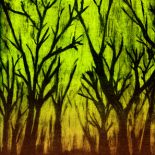Clathrus Crispus, the latticed stinkhorn
I like photo opportunities best when they seem to be presented to me, rather than preplanned or set up. It’s a serendipitous gift from nature in my eyes, providing a frisson of discovery. One day after work, my neighbor called me over to let me know she had seen some weird mushrooms down the block, just the kind of thing she knows I like taking pictures of! I literally ran into the house, grabbed my photo kit and continued down the block. After some little searching, I saw what looked like an impossibly shaped red entity perched on some mulch. I am not a mycologist, but this didn’t look like a mushroom to me.
It looked more like a melted red wiffle ball. I actually said aloud to myself “What the hell is this!?” Most passersby ignored it, more interested in the weirdo on his belly taking photos of an alien life form, that’s all. This individual was covered in flies and smelled like rotten meat, hence its common name, the latticed stinkhorn. Stinkhorns belong to the Phallaceae family of fungi, and quite often live up to their family name in shape, but not this particular species.
This friendly fungus is saprobic, i.e. feeding on already dead organic matter, and not attacking anything still living like some other types of fungi may. That’s why it’s so often being found on mulch in South Florida and the Gulf area — mulch is dead wood after all, where the stinkhorn’s spores may be present. It appears first as an egg-like structure, covered in a white veil, which grows until it splits open in slimy, stinky glory.
As it grows out of the egg stage (the “eggs” are said to be edible, but no. Just no.), the white disintegrates, leaving the red lattice structure to grow up into an oval, almost bulb shape. The sickly green areas open eventually to complete the hollowness of the fully formed fruitbody. The slime covering it exudes the smell of carrion to attract flies, and does it ever! The flies get to eat, and the mushroom in turn has its spored carried aloft by the flies, on their bodies as well as in their excrement.
If you live in the Southeast/Gulf Coast area, look for the latticed stinkhorn growing on mulch, but you might want to avoid breathing through your nose.






